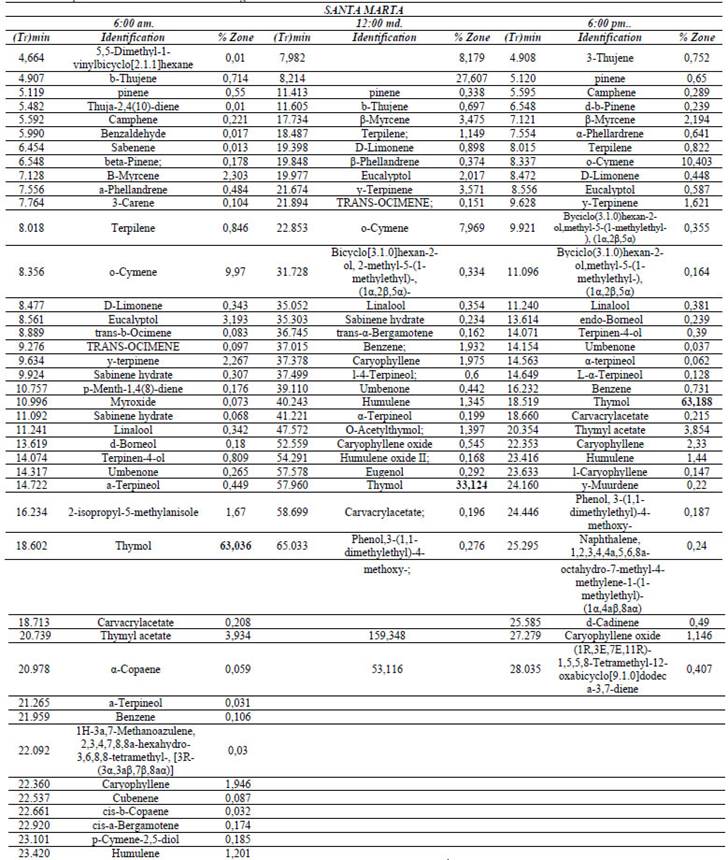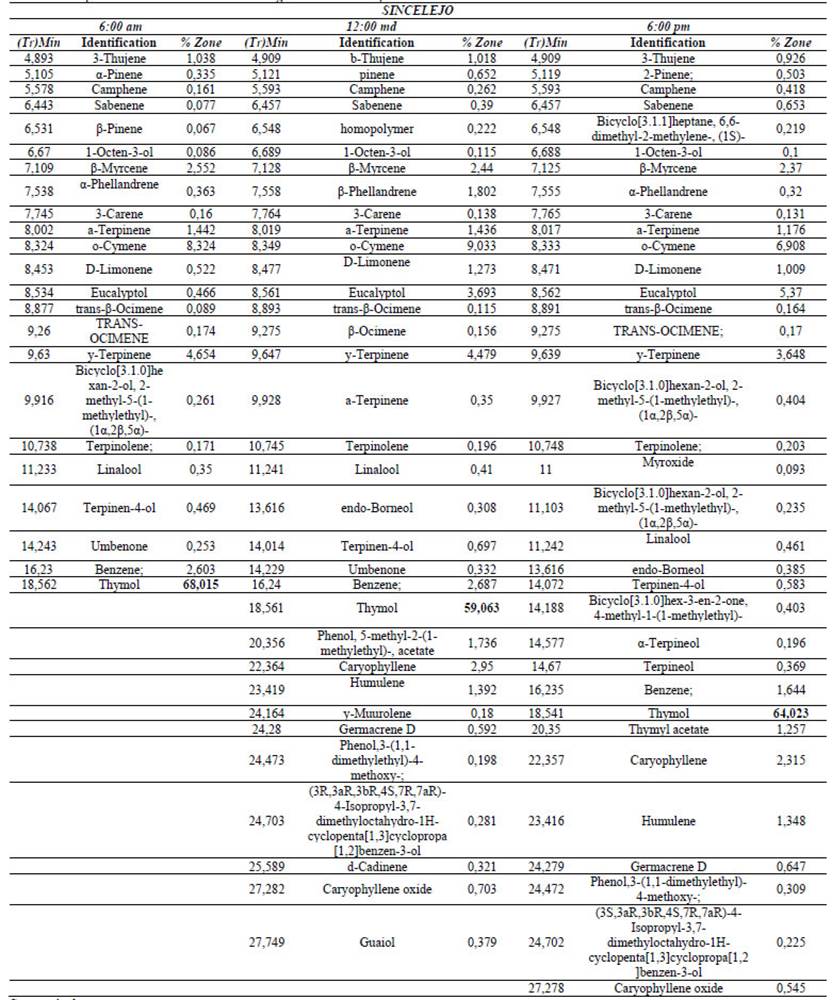1. Introduction
Oregano is the common name for the aroma and flavor in general derived mainly from more than 60 species of plants used throughout the world as a condiment or spice; two large groups of oregano are known: Mediterranean or European oregano and the Mexican. The first comes from various species of the genus Origanum vulgare subs. hirtum (Greek oregano) and O. vulgare subs. gracite (Turkish oregano). Mexican oregano comes from two species of the Verbenaceae Family: Lippia palmeri and mainly from Lippia graveolens. Oregano from genus Origanum (European) is generally extracted from well-established commercial plantations, while Mexican oregano is obtained from wild populations of almost the entire territory without any management plan. In Colombia, the so-called Mount Oregano Lippia origanoides is found in the wild, which is of Neotropical origin and all its characteristics indicate that it is specific with Lippia suaveolens, which grows from the south of the United States to Guatemala [1]. Most oregano species have remarkable medicinal properties, which are explained by the extraordinary and complex chemical composition of these plants.
In Colombia, L. origanoides is usually found in the departments of Guajira, Magdalena, Cauca (Alto Patia), Cundinamarca, Norte de Santander and Santander. In the latter it is found at altitudes between 500-800 m.a.s.l forming plant associations with other species characteristic of the region [2]. The L. origanoides species are small shrubs with larger leaves than the Origanum species and come mainly from Mexico, they are wild plants. The basic composition of the oil varies with the source of the plant and the geographic area of growth.
The essential oils studied in this project were extracted from the plant species Lippia Origanoides collected in two agro-climatic zones of Colombia (Sucre and Magdalena) in three periods of the day (Morning 6:00 a.m., noon 12:00 m.d. and afternoon 6:00 p.m.). In order to determine if the agroclimatic conditions of these two areas of Colombia influence the yield and concentration of said essential oil as a pesticide bio-input for yam plantations.
2. Methodology
2.1 Obtaining plant material
Samples were collected in two Agroclimatic Zones of Colombia in three periods of the day (Morning 6:00 a.m., noon 12:00 m.d. and afternoon 6:00 p.m). The first area is the Department of Magdalena, specifically in the Taganga Municipality and the second in the Sucre Department, specifically in the Municipality of Sampues district of Segovia. Similarly, georeferencing data, data on climatic parameters and soil samples were taken.
2.2 Sampling
Samples of plant material (leaves) of Lippia Origanoides in good phytosanitary condition were taken. Plant tissue samples were stored in Styrofoam refrigerators, labeled with the sampling date, sampling time and georeferencing of the site. Later, these were transported to the Microbiological Research Laboratory of the University of Sucre for the respective oil extraction procedures.
2.3 Sample preparation
110 gr of fresh material were taken and placed in a distillation flask with 300 ml of distilled water. This was done for the samples from each sampling area in defined periods.
2.4 Essential oil extraction process
After the sample was prepared for the extraction of essential oil, it was subjected to the hydrodistillation assisted by microwave radiation for fifteen minutes during three cycles. This procedure was performed for the samples from each analysis zone collected in defined periods.
2.5 Yield calculation
Percentage of yield from the volume of the oil in milliliters divided by the weight of the vegetable matter in grams per one hundred, as shown in the eq. 1.
2.6 Chemical analysis
Chemical components present in the extracted essential oils were characterized with an Agilent 6890N gas chromatography equipment coupled to an Agilent 5973N mass selective detector. Kovats indices were determined in a slightly polar capillary column DB_5MS length of 30 m x 320 um x 0.5um Helium with a pressure of 0.27psi and an average flow velocity of 40 cm/sec was used as carrier gas Initial oven temperature was 150 °C and the final 350 °C. The injector temperature was 250 °C and the detector temperature was 300 °C [3].
3. Results and discussion
3.1 Yield
Lippia Origaniodes essential oils were obtained with yields that vary between1.29% w / w to 2.03% w / w as shown in Table 1.
Table 1 Percentage (%) oil yield for the two agroclimatic zones and three hours of sampling

Source: Authors.
The yield calculations in the extraction of essential oils from Lippia Origaniodes, the highest yield was obtained in the city of Santa Marta at 6:00 pm with a value of 2.03%. In Table 1 can be observed that the lowest yield value in both cities is reported at 12:00 m, which indicates that high temperatures do affect the performance of essential oils.
When making the comparison between the yield values obtained in Sincelejo and Santa Marta, it is observed that there are differences between the two areas since Santa Marta reports higher yield values, which agrees with the theory since the yield of the essential oils of the species has variations even within the same families, depending both on the origin of the plant, the place and time of production as well as the age and care that it has had [4].
Yield results of L. origanoides reported for the Santander Department in two different locations, Pie de Cuestas with 4.4% and Los Santos with 1.5% [3], show that the zone where the sample is collected does influence. In the same way, yields of 2.92% [5], 3.1% [3] have been obtained for L. origanoides. However, these results indicate that these plants in either of the two ecological zones can be proposed as raw material for industrial exploitation since their yields are above the minimum value allowed which is 0.1% [6].
3.2 Chemical composition
Analysis by gas chromatography coupled to mass spectrometry allowed the identification of more than 120 different substances in the different samples of essential oils of L. origaniodes collected in the two agro-ecological zones, as shown in Tables 2 and 3.
Table 3 Chemical composition of the essential oils of L. origanoides in Santa Marta.

Source: Authors.
From Tables 2 and 3 it can be inferred that the compound with the highest concentration in the chemical profile of the essential oil samples of L. origaniodes for the two zones and the three collection times is thymol. Sincelejo presented the highest percentages of thymol with 68.02% at 6:00 am, 59.063% at 12:00 md and 64.023% at 6:00 pm; while in Santa Marta values of 63.036% are reported at 6:00 am, 33.124% at 12:00 md and 63.19% at 6:00 pm.
In all cases, the lowest concentrations of Thymol were found at noon, this is due to high temperatures can volatilize this compound [7] and in the case of Santa Marta, because it is a coastal area the temperature at noon is higher than in Sincelejo, therefore, concentrations of 33.12% and 59.06% were found respectively. A similar case occurs with Ocimeno and 3-Tujeno, which showed a decrease in concentration in this period.
Thymol has been identified in the species L. origanoides with a percentage between 34% to 58% [8] and 71.1% [5] and carvacrol with 26% [8] and 33% [9].
Significant amounts of thymol and carvacrol have been identified in the genus Lippia, which important effects such as antioxidants, antifungals and antibacterial have been attributed [10,11] since they have the property of increasing the ATP permeability of the cell membrane, altering the pH gradient, the membrane potential and disintegrating it [12], joining the hydrophobic proteins of the membrane by means of hydrogen bonds allowing the exit of K ions, ATP, proteins and causing the loss of homeostasis of the cell [13].
4. Conclusions
The best yields of the extraction of essential oils of L. origanoides were presented by the agroclimatic zone of Santa Marta at the time of collection at 6:00 p.m., with 4.91%. The results of the chemical profile of all essential oils of L. origanoides report thymol as the major metabolite with an area percentage of 68.02% at 6:00 for the one collected in Sincelejo, while that collected in Santa Marta at 6:00 was 63.19%.

















